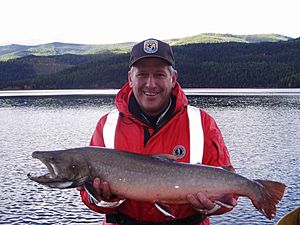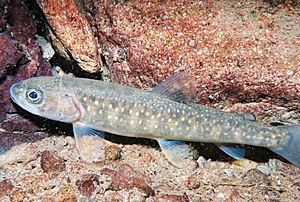Bull trout facts for kids
Quick facts for kids Bull trout |
|
|---|---|
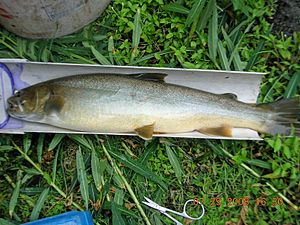 |
|
| Conservation status | |
| Scientific classification |
The bull trout (Salvelinus confluentus) is a type of char fish. It belongs to the Salmonidae family, which includes salmon and trout. You can find them in the cold waters of northwestern North America.
For a long time, the bull trout was thought to be the same as the "Dolly Varden" (S. malma). But in 1980, scientists decided it was a separate species. Today, the bull trout is listed as a threatened species in the U.S. It is also considered 'vulnerable' on the IUCN Red List of Threatened Species. This means it needs special protection.
Contents
What Does a Bull Trout Look Like?
Like other char fish, bull trout have white edges on their fins. They have a very large head and mouth. This big mouth is actually how they got their name.
Bull trout can grow quite big. Some have been found to be over 103 cm (41 in) long. They can also weigh up to 14.5 kg (32 lb).
- Migratory vs. Resident:
- Some bull trout are "migratory." This means they travel a lot. They move through big river systems, lakes, and even the ocean.
- Others are "resident." These fish stay in the same stream their whole lives.
Migratory bull trout are usually much larger. Resident bull trout rarely weigh more than 2 kg (4.4 lb).
- How to tell them apart:
- Bull trout are different from brook trout (S. fontinalis). Bull trout do not have spots on their dorsal fin (the fin on their back). They have yellow, orange, or salmon-colored spots on their back. Brook trout have red spots with blue rings.
- Bull trout also have a different tail fin than lake trout (S. namaycush). Lake trout have a deeply forked tail, but bull trout do not.
Where Do Bull Trout Live?
Bull trout live in cold, clear waters. You can find them in high mountains and coastal rivers. Their home is in northwestern North America. This includes places like Yukon, British Columbia, Washington, Oregon, Idaho, and western Montana. They are also found in the Jarbidge River in northern Nevada.
There is also a group of bull trout living east of the Continental Divide in Alberta, Canada. The bull trout is the official fish of Alberta. In the past, bull trout also lived in northern California. But they are probably no longer found there.
What Kind of Home Do They Need?
Bull trout are very picky about where they live.
- They need water temperatures that are usually below 55 °F (13 °C).
- They need clean gravel beds for laying their eggs.
- They like deep pools and places to hide. These hiding spots can be things like fallen trees (called snags) or undercut river banks.
- They also need large systems of connected waterways. This helps them move around for spawning (laying eggs).
Because of these needs, they prefer deep parts of cold lakes and big rivers. They also like high, cold mountain streams where rivers begin. Some bull trout living near the coast can even be anadromous. This means they travel between fresh water and the ocean. Some have even been seen moving from one coastal river to another by swimming through the ocean.
What Do Bull Trout Eat?
When bull trout are young, they eat tiny water creatures. These include zooplankton and zoobenthos, especially small insect larvae called chironomids.
As they grow bigger, they start to eat other fish. In coastal Washington, some bull trout eat a lot of salmon eggs and young salmon. They also eat other fish.
Protecting Bull Trout
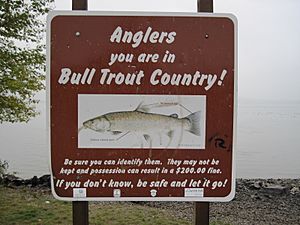
The bull trout is listed as a threatened species in the United States. This means it is protected by the U.S. Endangered Species Act. They are an important species for managing several national forests. These include Boise National Forest and Sawtooth National Forest. You can also find them in Glacier National Park.
Threats to Bull Trout
Bull trout need cold water and very little dirt (silt) for their eggs to hatch.
- Habitat Damage: Building roads and cutting down trees (logging) can make the water warmer and add more silt. This harms bull trout reproduction.
- Dams: Bull trout need to travel throughout river systems. Dams can block their path, making it hard for them to migrate.
- Other Fish: Bull trout populations are also in danger from mixing with non-native brook trout. When they mix, they can create hybrids that cannot have babies.
Fishing for Bull Trout
Bull trout are a popular game fish in northern Canada. In the past, some people disliked them. They feared bull trout would harm populations of other fish that anglers liked more. Today, some places have a rule: "No black, put it back." This means if a fish doesn't have black spots (like a bull trout), you should release it.
The Name "Dolly Varden"
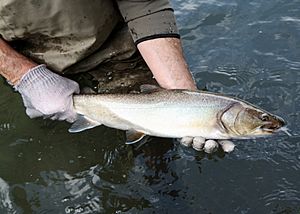
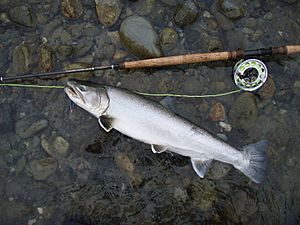
For many years, people were confused between the bull trout (S. confluentus) and the Dolly Varden trout (Salvelinus malma malma). This was because they lived in similar areas and looked alike.
How the Name "Dolly Varden" Started
The name "Dolly Varden" was first used for bull trout. This happened in the early 1870s in the McCloud River in northern California. A woman named Mrs. Valerie Masson Gomez shared a story about it. Her grandmother lived at a summer resort. Fishermen were looking at some colorful, spotted trout they called "calico trout." They wanted a better name.
Her grandmother, who was a teenager, had been reading a book by Charles Dickens. It had a character named Dolly Varden. Also, a popular fashion style at the time was called "Dolly Varden." It was a dress with patterns worn over a bright petticoat. Her grandmother had a new dress in this style. The red spots on the fish reminded her of her dress. She suggested, "Why not call them 'Dolly Varden'?" The men liked the idea. Guests at the resort then spread the new name.
Later, the original "Dolly Varden" trout (the bull trout) disappeared from the McCloud River. This happened in the 1970s. Other fish species, often introduced by people, competed with the bull trout. They could also breed with them, creating fish that could not have babies.
See also
 In Spanish: Salvelinus confluentus para niños
In Spanish: Salvelinus confluentus para niños



